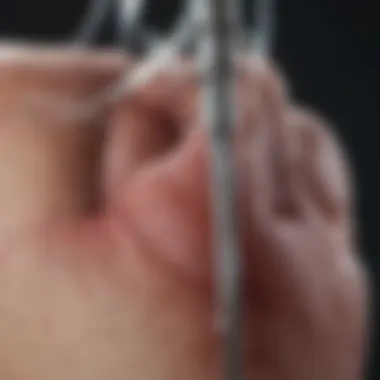Understanding Left Bundle Branch Block in Depth


Intro
Left Bundle Branch Block (LBBB) is a condition that may go unnoticed until it is assessed through an electrocardiogram (ECG). It occurs when the electrical signals that control heartbeats are delayed or blocked in the left bundle branch, which is part of the heart's conduction system. This can lead to alterations in heart function and potentially indicate underlying heart disease. Understanding LBBB is essential for healthcare professionals and researchers alike, as its presence may have significant implications for patient management and prognosis.
In this comprehensive overview, we will explore the factors contributing to LBBB, the various methods used for diagnosis, and the potential treatment pathways available. We will also discuss the broader significance of LBBB in relation to heart health and its connections to other cardiovascular conditions.
Engaging with this article will equip readers with knowledge that is not only relevant for clinical practice but also beneficial for academic endeavors.
Research Overview
Methodological Approaches
Various methodologies are employed to study LBBB. Clinical research frequently utilizes patient data collected from cardiac imaging, ECGs, and long-term follow-up studies. The importance of these methodologies cannot be overstated, as they help in determining the prevalence of LBBB and its impact on overall cardiovascular health.
Meta-analyses often pool results from multiple studies, allowing for a more robust understanding of LBBB's effects across different populations. This aggregation of data can highlight trends that might not be apparent when examining individual studies.
In addition to clinical studies, basic science research investigates the pathophysiological mechanisms underlying LBBB through experimental and computational models. These approaches help delineate the factors that contribute to the conduction delay, including anatomical abnormalities and functional disruptions in the myocardium.
Significance and Implications
The presence of LBBB carries important clinical significance. It is often associated with heightened risks of cardiovascular events, such as heart failure and arrhythmias. Understanding the implications of LBBB can assist healthcare providers in stratifying patient risk and tailoring treatment.
Furthermore, recognizing LBBB's potential to indicate underlying conditions, such as coronary artery disease or hypertension, underscores its relevance in preventive cardiac care. Relevant literature consistently highlights the need for physicians to take LBBB into account during diagnostic assessments and treatment planning.
"The identification of Left Bundle Branch Block can serve as a critical marker for underlying cardiac pathology and necessitates a thorough clinical evaluation."
Through comprehensive research, healthcare professionals can gain insights into appropriate management strategies, which may include pharmacological treatments and lifestyle modifications. The integration of this knowledge into clinical practice can lead to improved outcomes for patients affected by LBBB.
Current Trends in Science
Innovative Techniques and Tools
Emerging technologies contribute significantly to the way LBBB is diagnosed and managed. Advanced imaging techniques, such as cardiac magnetic resonance imaging (MRI), enable detailed visualization of the heart's structure and function. These tools may help identify causes of LBBB that were previously difficult to detect through standard methods.
Additionally, wearable cardiac devices are becoming more prevalent, allowing real-time monitoring of patients' heart rhythms. Such innovations facilitate earlier detection of LBBB and can provide valuable data for ongoing research into its clinical implications.
Interdisciplinary Connections
The study of LBBB is inherently interdisciplinary, intersecting fields such as cardiology, electrophysiology, and public health. Collaboration across these disciplines fosters a comprehensive understanding of the condition and its implications. For instance, research involving public health can enhance awareness of LBBB in different demographics, guiding targeted prevention strategies.
Educators and researchers are thus encouraged to engage in interdisciplinary communication to further enrich the dialogue surrounding LBBB.
Preface to Left Bundle Branch Block
Left Bundle Branch Block (LBBB) is a significant topic within cardiology and has implications for patient management and healthcare outcomes. Understanding LBBB is crucial as it can alter electrical conduction in the heart. This disruption presents risks that may complicate existing cardiac conditions. Thus, knowledge of LBBB is beneficial for students, researchers, educators, and healthcare professionals.
This article provides a comprehensive analysis of LBBB. The aim is to highlight its clinical relevance while offering insight into its diagnosis and management strategies. Through this exploration, readers will appreciate how LBBB affects heart functionality, its diverse causes, and possible interventions.
Definition of Left Bundle Branch Block
Left Bundle Branch Block refers to a condition where there is a delay in the electrical signals traveling through the left bundle branch of the heart's conduction system. The delay can lead to varied heart rhythms, affecting the efficiency of the heart's ability to pump blood. This condition is not a disease in itself but often a sign of another underlying issue. LBBB can be identified through specific patterns on an electrocardiogram (ECG).
Understanding the Cardiac Conduction System
The cardiac conduction system is essential for maintaining heart rhythm and proper functioning. It consists of specialized cardiac muscle cells that generate and conduct electrical impulses throughout the heart. The system includes the sinoatrial node, atrioventricular node, His bundle, and bundle branches, which coordinate the heartbeat.
- Sinoatrial Node: Often called the heart's natural pacemaker, it initiates electrical impulses.
- Atrioventricular Node: Acts as a gatekeeper, slowing impulses before they travel to the ventricles.
- His Bundle: Conducts impulses from the atrioventricular node to the left and right bundle branches.
- Bundle Branches: These carry the impulses to the left and right ventricles, ensuring synchronized contraction.


In the case of LBBB, the impulse conduction through the left bundle branch becomes obstructed, resulting in asynchronous contraction of the left ventricle, which can have serious consequences for overall heart health.
Mechanism of Left Bundle Branch Block
Understanding the mechanism behind Left Bundle Branch Block (LBBB) is essential for discerning how it affects cardiac function. The conduction system of the heart relies on an intricate network of pathways through which electrical impulses travel, coordinating the heart's rhythm. Any disruption in these pathways can lead to significant clinical implications. Thus, a detailed grasp of the anatomy involved and the resulting pathophysiological changes will contribute greatly to both diagnosis and treatment.
Anatomy of the Bundle Branches
The bundle branches are crucial components of the heart's conduction system. They arise from the atrioventricular (AV) bundle, also known as the bundle of His. This bundle divides into the right and left bundle branches, with the left branch further splitting into anterior and posterior fascicles.
The anatomy of the left bundle branch can be described as follows:
- Left Bundle Branch: It conducts impulses to the left side of the heart, aiding in the contraction of the left ventricle. The separation into fascicles allows for more precise coordination of contraction.
- Right Bundle Branch: This branch transmits impulses to the right ventricle, providing crucial support in maintaining synchronized heart function.
Disruption in conduction through these branches can lead to LBBB. This condition is often the result of abnormalities in heart tissue or the development of scar tissue from ischemic events, which causes a delay in the transmission of impulses. Understanding these anatomical details highlights the significance of any disruption in the conduction pathways of the heart.
Pathophysiology of LBBB
The pathophysiology of Left Bundle Branch Block includes the biological processes and conditions that lead to this impairment. In a normal heart, electrical impulses travel down the AV bundle and subsequently into both the right and left bundle branches simultaneously.
In LBBB, the left bundle branch has a delayed conduction or is completely blocked. This results in:
- Asynchronous Ventricular Contraction: The left and right ventricles do not contract simultaneously, which can reduce the efficiency of the heart's pumping ability.
- Altered Electrical Patterns: LBBB imprints a specific pattern on the ECG, which includes widened QRS complexes and changes in the ST segment and T waves. Clinicians rely on these patterns to diagnose the condition.
- Impact on Cardiac Output: The inability to contract in a coordinated manner can lead to inadequate perfusion to various organs, potentially causing symptoms like fatigue, shortness of breath, or even heart failure in severe cases.
"LBBB can profoundly affect cardiac hemodynamics and may be associated with higher morbidity and mortality, making it a critical condition to understand."
Causes of Left Bundle Branch Block
Understanding the causes of Left Bundle Branch Block (LBBB) is essential for a comprehensive insight into this cardiac condition. Identifying the triggering factors aids healthcare professionals in diagnosing and managing patients effectively. LBBB is not an isolated issue; rather, it often signifies an underlying pathology. The causes can be broadly categorized into cardiac and non-cardiac origins. Each category carries its implications and understanding these nuances enhances patient management and treatment strategies.
Cardiac Causes
Myocardial Infarction
Myocardial Infarction, commonly known as a heart attack, is one of the prominent cardiac causes of LBBB. During a heart attack, the blood flow to a part of the heart is interrupted, leading to tissue damage. This damage can disrupt the electrical pathways, including the bundle branches. This is significant as the electrical conduction delay directly contributes to the LBBB presentation on an ECG. The key characteristic of Myocardial Infarction is its acute nature, causing sudden and often severe symptoms. It is a common choice for discussion due to its relevance in clinical settings. However, it has unique features like ongoing risk for further cardiac events and complications, making it a double-edged sword in patient management.
Cardiomyopathy
Cardiomyopathy represents a group of diseases that affect the heart muscle's ability to pump blood effectively. It has various forms, including dilated and hypertrophic cardiomyopathy, both of which can lead to LBBB. The primary aspect of Cardiomyopathy is its chronic nature, with many being progressive. This condition is vital to explore in this article due to the direct impact on heart function and resulting electrical conduction issues. Unique to this disease is its gradual degeneration of cardiac muscle which can exacerbate symptoms over time. The disadvantages include a complex management approach requiring multidisciplinary care for optimal outcomes.
Aortic Stenosis
Aortic Stenosis involves narrowing of the aortic valve opening, impeding blood flow from the heart into the aorta and on to the rest of the body. The key characteristic is the pressure overload on the left ventricle. This pressure overload can lead to hypertrophy of the heart muscle, disrupting normal conduction. Discussing Aortic Stenosis is relevant in the context of LBBB since they often coexist in elderly populations. Its unique feature includes the gradual onset of symptoms such as exertional dyspnea and chest pain, complicating the diagnosis. In terms of advantages, early detection can help manage symptoms effectively, while disadvantages arise from potential surgical interventions required to alleviate the stenosis.
Non-Cardiac Causes
Hypertension
Hypertension, or high blood pressure, is a prevalent condition that can lead to LBBB over time. The sustained high pressure can stress the heart, leading to left ventricular hypertrophy. The key characteristic of Hypertension is its insidious onset, often remaining asymptomatic until significant damage has occurred. Its discussion is crucial since it is very common in the population. A unique feature of Hypertension is that it often requires long-term management strategies. Its advantage lies in the fact that effective lifestyle changes and medications can significantly decrease risk of developing LBBB and other complications.
Chronic Lung Diseases
Chronic Lung Diseases, such as Chronic Obstructive Pulmonary Disease (COPD), influence the cardiovascular system in many ways, including contributing to cardiovascular strain. These conditions can lead to a decrease in oxygenation and create additional stress on the heart which can contribute to LBBB. The key characteristic is the respiratory compromise that may indirectly affect cardiac function. As these diseases are increasingly common, understanding their implications is essential. Their unique feature includes potential overlap in symptoms with cardiac conditions, creating diagnostic challenges. While they are manageable, their presence complicates treatment due to polypharmacy and comorbidities.
Electrolyte Imbalances
Electrolyte Imbalances, such as those involving potassium, sodium, or calcium, can have significant effects on cardiac function. These imbalances can alter electrical conduction within the heart, leading to conditions like LBBB. The critical aspect is their reversible nature with appropriate management. The article highlights electrolyte imbalances as they are often found in various clinical scenarios, emphasizing the need for vigilant monitoring. The unique feature is that imbalances can occur rapidly and may need immediate correction in acute settings. Their advantages are seen when recognizing and correcting imbalances can lead to improved cardiac function, although there can be disadvantages due to their frequent association with broader systemic health issues.


Clinical Presentation of Left Bundle Branch Block
Understanding the clinical presentation of Left Bundle Branch Block (LBBB) is critical in this article. It allows readers to recognize the signs and implications of the condition, which is often stigmatized in the broader context of cardiac health. The symptoms manifested by LBBB can range from subtle to overt, depending on the individual’s overall cardiac function and the presence of comorbidities. Awareness of these symptoms is crucial for timely diagnosis and intervention, directly impacting patient outcomes.
Symptoms Associated with LBBB
The symptoms associated with LBBB can vary significantly. Some patients may experience no noticeable symptoms, leading to the condition being discovered incidentally during an electrocardiogram. However, common symptoms in those who do exhibit clinical signs include:
- Fatigue: Many individuals report a general feeling of tiredness, which can be frustrating and misunderstood.
- Shortness of breath: This symptom may occur especially during physical activity or exertion.
- Palpitations: Some patients experience an unusual awareness of their heartbeats, which can be unsettling.
- Chest pain or discomfort: This may be occasional and is often linked to exertion, necessitating further evaluation to rule out other heart conditions.
- Dizziness or fainting: These symptoms can indicate a more severe underlying issue and require immediate medical attention.
Notably, the lack of specific symptoms in many individuals adds complexity to the presentation of LBBB. Thus, healthcare professionals must maintain a high index of suspicion when evaluating patients with risk factors for cardiac disease.
Impact on Heart Function
LBBB can have significant effects on heart function. It disrupts the normal electrical conduction system of the heart, resulting in asynchronous contraction of the ventricles. This asynchronous contraction can lead to compromised cardiac efficiency, particularly during times of increased demand, such as during exercise. Key impacts include:
- Reduced Cardiac Output: Due to the poor coordination between the left and right ventricles, a decrease in overall pumping efficiency can occur.
- Increased Risk for Heart Failure: Over time, the strain on the heart can lead to worsening heart failure, especially in patients with preexisting cardiac conditions.
- Potential for Sudden Cardiac Events: In some cases, LBBB may be associated with a higher risk for arrhythmias or other serious complications.
Understanding these impacts is essential for both patients and healthcare providers, as it guides the management approach and potential treatment strategies. Identifying symptoms and grasping the functional consequences of LBBB leads to a more informed discussion regarding the importance of monitoring and proactive management of the condition.
Diagnostic Approach to Left Bundle Branch Block
The diagnostic approach to Left Bundle Branch Block (LBBB) is crucial in understanding how to identify and manage this conduction delay. Proper diagnosis not only confirms the presence of LBBB but also reveals the underlying conditions causing it. Physicians often rely on various diagnostic tools to assess heart health and the consequent impact of LBBB on a patient's overall cardiovascular status. A comprehensive evaluation is vital since timely and accurate diagnosis can significantly affect treatment options and prognosis.
Electrocardiogram (ECG) Findings
An Electrocardiogram (ECG) is the primary diagnostic tool used for detecting left bundle branch block. The keypad ECG can show characteristic waveforms that indicate LBBB presence. Key findings on an ECG include:
- Prolonged QRS duration: One of the hallmark signs of LBBB is a QRS complex longer than 120 milliseconds, indicating delayed electrical conduction.
- Broad, notched R waves: In leads I, aVL, V5, and V6, a notched or slurred R wave pattern often appears, which is distinct in identifying the left bundle branch block.
- Absence of Q wave: There is usually an absence of the Q wave in leads that follow the left ventricular depolarization pattern, further aiding the diagnosis.
Understanding these findings is essential for clinicians to differentiate LBBB from other conduction disturbances, like right bundle branch block or other arrhythmias. Correct interpretation allows for thorough assessment and consideration of potential underlying cardiac pathology.
Differential Diagnosis
Differential diagnosis is a critical step as it involves distinguishing LBBB from other similar conditions. It helps to clarify the cause of the conduction delay and informs treatment strategies. Conditions to consider include:
- Right Bundle Branch Block (RBBB): Clinicians must differentiate this condition from LBBB as the management and predictive implications differ.
- Myocardial Infarction: In acute settings, ST elevation may confuse conditions leading to misdiagnosis. It is vital to assess other cardiac markers and symptoms.
- Ventricular Hypertrophy: This condition may present with similar ECG findings, necessitating the need for additional imaging or echocardiographic studies.
- Infiltrative Diseases: Conditions such as amyloidosis or sarcoidosis can also cause conduction anomalies, and special tests might be necessary to identify their presence.
A meticulous approach in differential diagnosis is paramount. It ensures patients receive the most appropriate care and treatment plans tailored to the underlying causes of their LBBB.
Management and Treatment of Left Bundle Branch Block
The management and treatment of Left Bundle Branch Block (LBBB) are crucial aspects of patient care. Correct handling of LBBB not only improves heart function, but also reduces associated risks. The choice of management strategies greatly depends on the underlying causes and the patient's overall condition. This section delves into the various methods used in the management of LBBB, including medical management and interventional strategies. Each treatment option offers specific benefits and considerations, emphasizing the importance of personalized care in treating LBBB.
Medical Management
Use of Medications
The use of medications in the treatment of LBBB often focuses on addressing the contributing factors. Medications such as beta-blockers and ACE inhibitors can help manage blood pressure and reduce strain on the heart. Their effect on heart rate and blood pressure is particularly beneficial. Patients may experience improved symptoms such as fatigue and shortness of breath. However, careful monitoring is essential, as these drugs can lead to side effects like hypotension or bradycardia. Adjustments may be needed based on individual response, making the careful selection of medications vitally important.
Management of Comorbidities
Management of comorbidities significantly impacts the overall treatment of LBBB. Many patients have related heart conditions such as hypertension or heart failure. Addressing these comorbidities is not only beneficial but often necessary for effective LBBB management. This may involve lifestyle modifications, dietary changes, or additional medications tailored to each condition. A comprehensive approach aids in improving heart function and overall patient well-being. However, it requires coordination among healthcare providers and patients to effectively manage multiple aspects of health.
Interventional Strategies
Cardiac Resynchronization Therapy


Cardiac Resynchronization Therapy (CRT) is an important interventional strategy for patients with LBBB, particularly for those with heart failure symptoms. CRT uses a specialized pacemaker to coordinate contractions between the heart's chambers. This synchronization often leads to enhanced cardiac output and improved functional capacity for patients. CRT can alleviate symptoms like fatigue and improve quality of life. However, patient selection is crucial, and not all patients will benefit from this approach; some may experience complications related to the device or procedure.
Pacemaker Indications
The use of pacemakers in LBBB management is often indicated in specific scenarios. Patients with significant heart block or who are symptomatic may require pacing to ensure adequate heart rate and rhythm. Pacemakers can effectively manage arrhythmias and restore normal electrical conduction. They are generally considered beneficial for improving overall heart function and relieving symptoms. However, they also come with risks such as infection, lead dislodgement, or device malfunction. Therefore, careful evaluation and ongoing monitoring are necessary to optimize outcomes.
Effective management of LBBB requires a tailored approach that considers both pharmacologic and interventional strategies. Each treatment plan must be individualized, reflecting the unique health profile of the patient.
Prognostic Implications of Left Bundle Branch Block
Left Bundle Branch Block (LBBB) has significant prognostic implications that warrant careful analysis. Recognizing the effects of LBBB on the heart's function and its potential relationship with underlying heart conditions is crucial for both diagnosis and treatment strategies. Understanding these implications is essential in guiding clinical decision-making and patient management.
Outcomes in Patients with LBBB
Patients diagnosed with LBBB often face variable outcomes. Research shows that LBBB can be associated with a higher incidence of heart failure and cardiovascular morbidity. Several studies indicate that the presence of LBBB can signify underlying cardiac pathology, which affects the prognosis. For instance, patients with existing coronary artery disease and LBBB have an elevated risk of heart-related events.
Regarding mortality, a meta-analysis highlighted that individuals with LBBB have an increased risk of death compared to those without. These patients may present with silent ischemia or heart failure symptoms, often complicating the clinical picture. Regular monitoring of patients with LBBB is therefore advised to promptly identify any progression of heart disease.
Outcomes can also be intrinsically linked to the underlying causes of LBBB. If the block is due to conditions like myocardial infarction, the prognosis hinges on the extent and management of that infarction, emphasizing the need for individualized care.
LBBB in Heart Disease Risks
LBBB is not merely an electrocardiogram finding; it is closely related to various heart disease risks. The presence of this conduction disturbance can serve as a marker for cardiovascular risk assessment. It has been established that individuals with LBBB often experience more severe heart disease outcomes.
Research has shown that LBBB can contribute to a higher likelihood of developing dilated cardiomyopathy. This condition can arise due to the heart's impaired ability to contract effectively, leading to reduced cardiac output. Additionally, patients with LBBB are more likely to experience arrhythmias, such as atrial fibrillation, which can further complicate their cardiac health.
A systematic review pointed out that LBBB serves as a signal for clinicians to be vigilant about concurrent heart diseases. This awareness can lead to earlier interventions, potentially improving overall patient outcomes. Regular echocardiograms and follow-up appointments can help doctors track heart function and make timely decisions regarding treatment.
"Left Bundle Branch Block should not be overlooked as it indicates significant underlying heart issues that can profoundly affect patient outcomes."
By recognizing the implications of LBBB, healthcare providers can better navigate the complexities of treatment and offer tailored approaches that enhance patient care.
Research and Advances in Understanding LBBB
Research on Left Bundle Branch Block (LBBB) is crucial for medical professionals. It not only helps in understanding the condition but also enhances patient care. With advances in technology and medical knowledge, new insights are emerging. These findings improve diagnostic accuracy and treatment protocols. They influence how healthcare providers view the prognostic implications of LBBB. Understanding the latest research provides valuable context for the management of patients with LBBB. It can help in identifying the best approaches for patient outcomes.
Recent Studies on LBBB
Recent scientific studies have focused on the relationship between LBBB and various heart conditions. One significant area of research is the association of LBBB with heart failure. Findings suggest that LBBB may worsen heart failure outcomes. A study indicated that patients with heart failure and LBBB have higher morbidity rates. Another important study involved the prognostic value of LBBB in patients with aortic stenosis. The presence of LBBB has been linked to increased mortality rates in these patients. Such studies clarify the implications of LBBB in regards to specific cardiac pathologies. They underscore the need for ongoing monitoring and treatment adjustments.
Innovations in Diagnostic Technologies
Diagnostic technology is evolving rapidly, offering new methods to assess LBBB. Innovations in imaging and electronic monitoring are making it easier to diagnose this condition. Advanced imaging techniques like cardiac MRI and echocardiography are assisting in identifying structural heart changes. Such methods aid in understanding the underlying causes of LBBB.
Additionally, wearable technology is becoming relevant. Devices capable of continuous heart rhythm monitoring can detect LBBB episodes. This real-time data allows for quicker clinical decisions.
"Innovative diagnostics are reshaping the approach to managing LBBB, ultimately improving patient outcomes."
These innovations yield precise data for treatment plans. They enhance the capability of clinicians to provide personalized care, reflecting the intricate nature of each patient's condition. Embracing these advancements in technology will likely lead to significant improvements in managing patients with Left Bundle Branch Block.
Closure
Understanding Left Bundle Branch Block (LBBB) is crucial for both clinical and academic settings. The insights provided throughout this article underline the importance of recognizing LBBB's implications on heart health. With its complex interplay between cardiac conduction abnormalities and various underlying conditions, LBBB demands a nuanced approach in both diagnosis and management.
Key Takeaways on Left Bundle Branch Block
- Definition and Mechanism: LBBB represents a disruption in the electrical conduction system of the heart, primarily affecting the left bundle branch. This delay can lead to various cardiac symptoms or may remain asymptomatic.
- Causes and Risk Factors: Various cardiac and non-cardiac factors contribute to the development of LBBB. Recognizing these can aid in identifying patients at risk and implementing preventive measures.
- Diagnostic Approaches: The role of an electrocardiogram (ECG) is fundamental in diagnosing LBBB. Health professionals should be aware of the characteristic patterns that indicate this condition.
- Management Strategies: Treatment often involves addressing the underlying causes, alongside potential interventions that might include medications and surgical options such as cardiac resynchronization therapy.
- Prognostic Implications: Patients with LBBB can have varying outcomes, which further emphasizes the need for personalized care strategies based on individual health profiles.
The Future of LBBB Research
Future research on Left Bundle Branch Block holds significant promise. Investigators are exploring the genetic and molecular pathways that may contribute to its development. Advanced imaging techniques and novel biomarkers are under evaluation to enhance diagnostic precision and therapeutic interventions.
Additionally, the link between LBBB and adverse cardiac events is a subject of ongoing studies. Improved understanding in this area may guide clinical decision-making and risk stratification.
Overall, as awareness and understanding of LBBB increase, so too does the potential for improved patient outcomes through better diagnostics and treatment frameworks.



